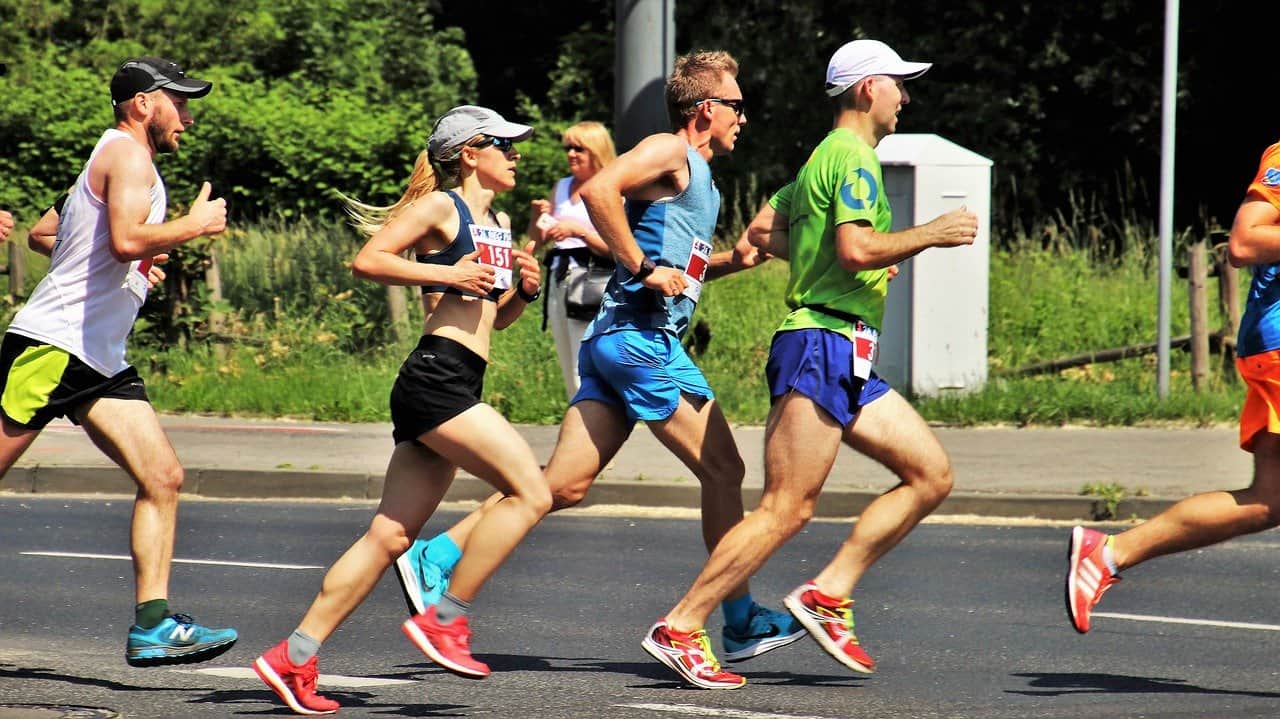A stereotypical marathon runner’s body is skinny and tall. Since cardio is a catabolic activity, many people shy away from long-distance running.
In our experience, a marathon runner can still enjoy a healthy physique. It’s all about balancing strength and endurance with full nutrition.
In this post, we’ll cover the body requirements, training, diet, and recovery steps for marathon runners. You’ll also find ways to strengthen your leg muscles and run with a flat foot. Let’s dig in!
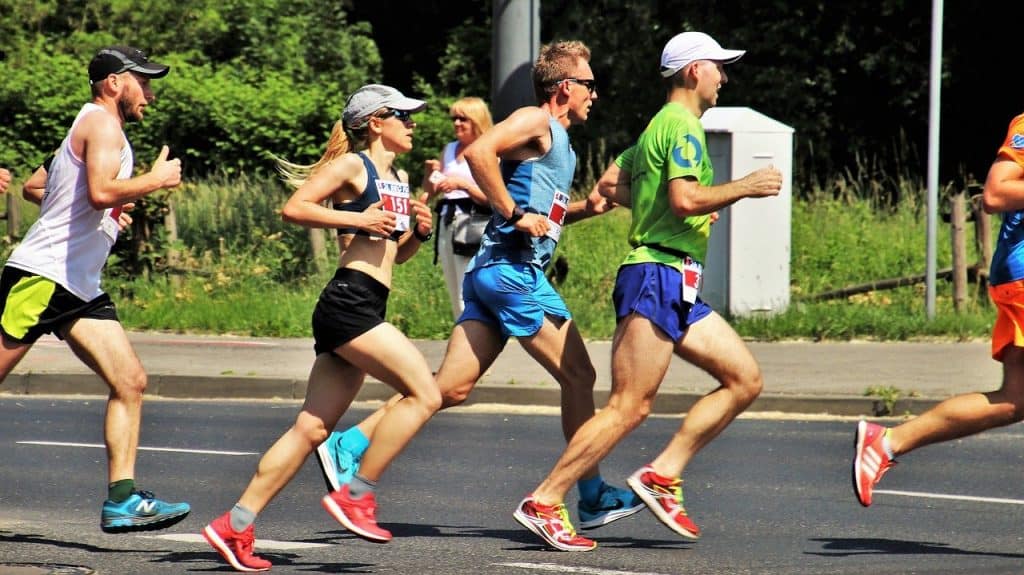
Top 10 Marathon Runner’s Body Requirements
People run marathons regardless of age and body type. However, there are a few things in common between the professional runners.
Let’s take a look at what makes a marathon runner’s body fit for aerobic sports:
1. Healthy Bones
Turns out, your parents weren’t kidding about calcium. Professional runners need strong bones, especially in the thighs, pelvis, and vertebra.
According to a recent study, avid marathon runners have around 11% more total body calcium than the average person.
2. Low Body Fat Content
This one’s very noticeable if you take a look at the most famous distance runners. They tend to be on the lean side. After all, it must be easier to run without all the extra weight.
Body fat distribution can make all the difference, too. Runners rarely have fat deposited on their hands and legs, but they can have a bit of abdomen fat.
3. Average Height
Unlike what you may think, you don’t have to be super tall to run a marathon. In fact, most professional runners are below 6’.
For men, the average height is 5’5”. Meanwhile, the women are around 5’3”. For reference, Eluid Kipochoge is 5’7” and Mary Keitany is 5’2”.
4. Slow-Twitch Skeletal Muscle Fibers
Muscular strength may be crucial for lifting, but it isn’t all that important for marathons. Instead, endurance is key. Endurance for running basically means slow-twitch muscles.
Slow-twitch muscles (also called type 1 or red fibers) help resist fatigue. This is because they have a higher energy production capacity. Muscle composition is mainly genetic, but training can help.
5. High Muscular Adaptation
Do you know the swelling and tenderness you feel after a tough workout? That is because some fibers are damaged.
When runners exercise regularly, their muscular adaptation becomes sharpened. This means that they recuperate faster.
6. Athletic Heart Rate
A person who’s used to cardio exercise has a lower resting heart rate. This is true for most endurance athletes, not just marathon runners.
If the average resting heart rate is 60 bpm, then a runner’s heart rate is around 40 bpm. This is because the heart muscles are stronger and can pump more blood in each heartbeat.
7. High Oxygen Uptake (VO Max)
Your VO max is a measure of how well your body uses the oxygen you breathe. It indicates good heart strength, lung capacity, and circulatory health.
The maximal graded exercise test is a good estimate to start with. An elite marathon runner can have a VO max value up to 85ml/kg/min.
8. High Lactate Threshold (LT)
Lactate is a metabolic by-product of anaerobic cellular respiration. The lactate threshold is when muscles run out of oxygen and start producing lactate faster than the blood can clear it out.
Trained marathon runners usually have a higher lactate threshold at about 75% of the VO2 max. This means that they resist cramping better than the average person.
9. Good Breathing Technique
There are different breathing techniques while running. However, breathing through both the mouth and nose seems to work the best for most runners.
It keeps your diaphragm engaged and helps maintain a rhythmic flow of oxygen. The more you speed up, the more you’ll find yourself shifting from nasal to mouth breathing.
10. Moderate Foot Arch
Normally, feet have an arch that makes walking and running much easier. With a high arch, you’ll have an advantage as a marathon runner.
While it’s not impossible to run a marathon with flat feet, it can be a bit challenging. Customized running shoes for flat feet can help significantly. More on that later!
Are My Leg Muscles Strong Enough to Run a Marathon?
In our opinion, the easiest way to know if you have the legs for running is to run and see. Try out your stamina in small runs. This will give you an idea about which muscles need work.
Before you start comparing your legs to professionals, let’s see how demanding running is in terms of muscle mass.
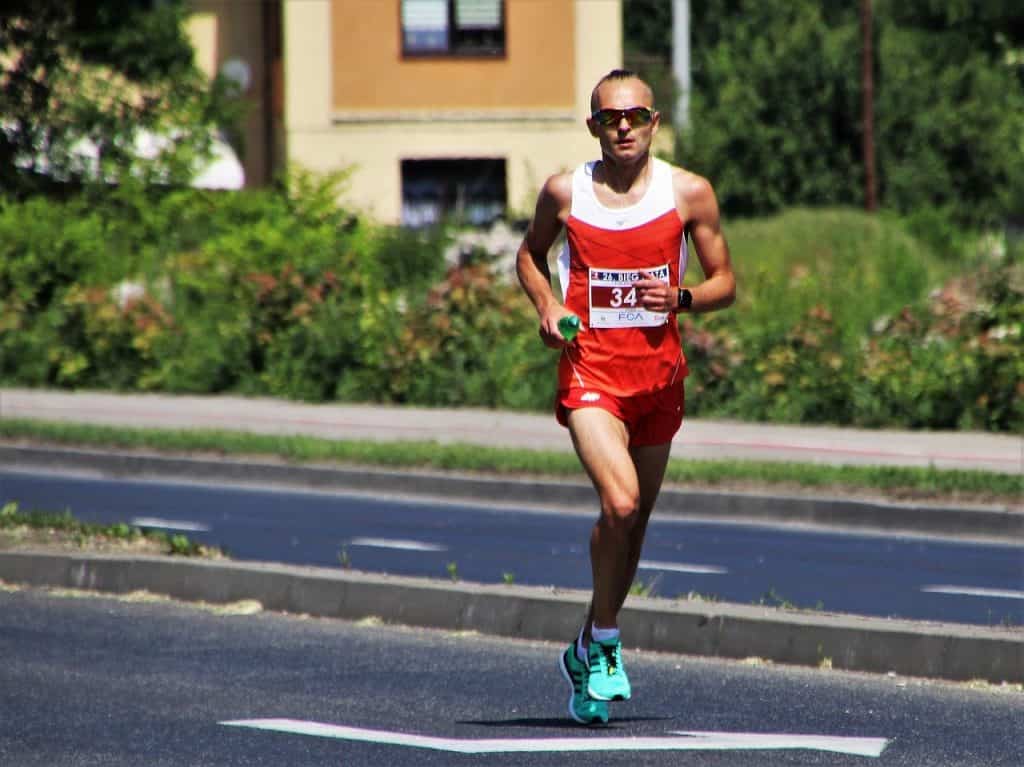
What Leg Muscles Does Running Use?
Running is mainly a cardio activity. The muscle that you’re training the most while running is your heart. Aerobic exercises, in general, are excellent for maintaining a healthy heart.
However, leg muscles also play a vital role in any runner’s training. During a typical run, you’re exercising the following:
Quad Muscles
The first leg muscles that you use in running are the quads. Each leg has four quads on the front of the thigh bones.
Quad muscles help bend the knees during walking and running. They also contribute to the hip bending movement.
Preventing Quad Injuries
The rectus femoris injuries are the most common among the quad muscles. Stretching before every run can save you a painful quad injury.
To warm up your quads:
- Stand straight on a flat surface
- Pull one foot up all the way back to your glutes
- Keep holding the foot for a few seconds
Hamstring Muscles
On the other side of the thighs, you have the hamstrings. The hamstrings are four muscles that extend from the hip joint to the knee.
Hamstrings help the knees bend safely. They also help with hip extension movements.
A runner should have prominent hamstrings that resist fatigue.
Preventing Hamstring Injuries
Losing the hamstring function can wear down the tendons. Don’t do any stretches if you already have tendon weakness.
Here’s a simple exercise to stretch your hamstrings:
- Put your feet on a high surface, like a table or even a curb
- With a straight back, bend your hip closer to the extended leg
- Try to pull your chest forward and hold the position for a few seconds
Calf Muscles
Each leg has two calf muscles that extend from the Achilles tendon and meet at the heel. The larger part of the calf is the gastrocnemius. Behind it is the smaller soleus.
The calves help lift the feet with every step you take. People with sedentary lifestyles usually feel a burn in their calves after their first run.
Preventing Calf Injuries
The main cause of calf injury is when the calves are overcompensating. This happens when other running muscles, like the hip flexor or the glutes, are weak.
During your marathon training period, make a habit of doing these calf stretches:
- Sit on a flat surface with both your feet extended
- Cover one foot with a resistance band and hold the ends in your hands
- Push the band with your toe and hold for a few seconds
Foot Muscles
Quite often, the foot gets neglected when people are training for marathons. People believe that buying a quality running shoe replaces the need for feet warm-ups; that’s just not true!
Any marathon runner needs to consider their feet during exercising and warming up. This is particularly important if you have flat feet.
Preventing Foot Injuries
A runner can injure their foot in many different ways. Unfitting shoes, rigid ankles, or weak calves can all put extra stress on the foot muscles.
To effectively stretch your feet muscles, follow these simple steps:
- Do toe lifts by relaxing four toes and focusing on isolating just one toe
- Alternate the toes after sets of 20 lifts
- Get a small ball to curl your toes around it and hold it for a few seconds
What Is the Best Marathon Training Routine?
We believe that preparing for a marathon is even harder than running it. It takes months of dedication and perseverance to be able to make it to that finish line.
A good training routine can make all the difference, especially for a novice runner. Let’s take a look at how you can get a marathon runner’s body:
Should Marathon Training Focus on Strength or Endurance?
Strength training is all about building new muscle mass and making the existing mass stronger. This should be your focus if you lack basic muscular strength or have a sedentary lifestyle.
Aerobic endurance is the way to a marathon runner’s body. You’ll need to run around three hours on the weekends plus an hour or so for every weekday.
During the final week, stop all strength training. You shouldn’t need to build new muscles by now. Focus on stretching and endurance trial runs only.
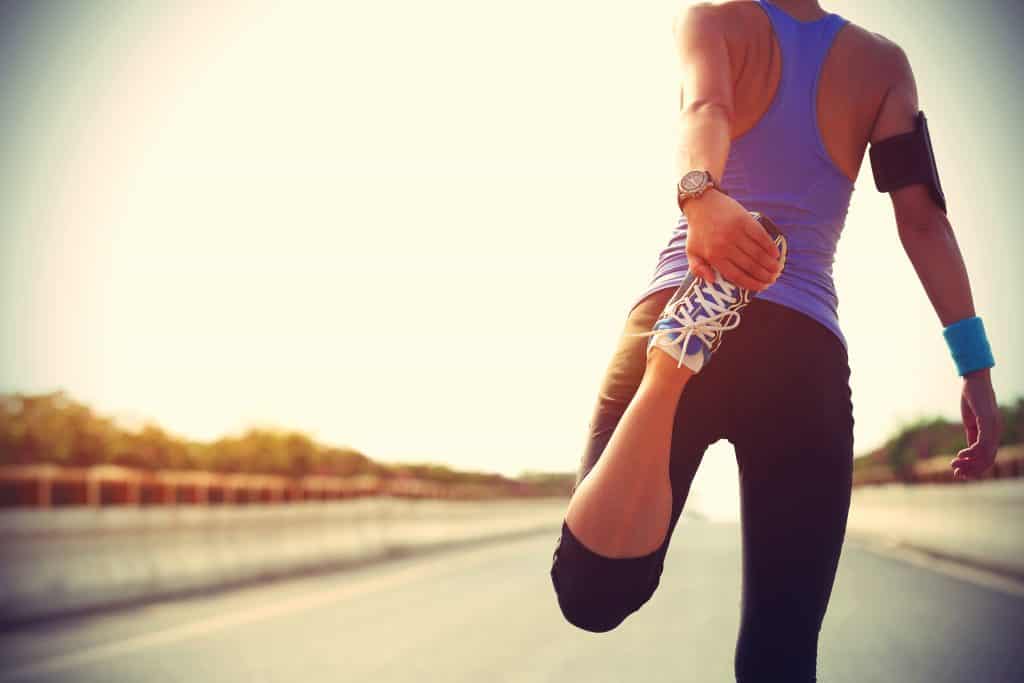
What Diet to Follow During Marathon Training?
A runner’s diet is mainly based on carbohydrates. Around 60% of your total calorie intake should be from carbohydrates. Check your required calorie intake for an accurate calculation.
Proteins are essential for muscle repair and maintenance. Include around 5% to 10% protein calories daily.
The training itself should help cut body fat down. So, you shouldn’t try to follow a strict diet for weight loss. Remember that people of different body shapes can run marathons.
How Long Does Marathon Training Take?
For a beginner, marathon training can take anywhere between four and six months. Of course, the sooner you start, the better you’ll perform.
It might be a good idea to keep an eye on the upcoming marathon events. This way you’ll be able to prepare and book your place in advance.
The important thing is to stick to your training schedule. People don’t run marathons with half-prepared bodies. It’s a huge commitment to make, but it’s going to be worth it.
How to Do Mileage Adjustment for a Marathon?
For beginners, you’ll need to start training with the lowest mileage possible. Gradually increase the distance of your runs as the event approaches.
Two weeks before the event, cut down on long-distance runs. Do around half the marathon’s mileage only for each run. It’ll help rest your body before the event.
Three or four days before the marathon, run the full mileage. We’d recommend doing it in the same gear and shoes. Think of it as a trial run.
What to Eat Before a Marathon?
Eating before a running event can be tricky. You want to fuel up for the run, but you also need something easy to digest.
A marathon pre-meal should revolve around carbo-loading. Protein should be included in moderation and fats should be eliminated entirely.
Carbohydrates
Carbohydrates are a runner’s best friend. Depending on your appetite, you can choose different sources.
You’ll need around 50g of carbohydrates before a run. A cup of regular cereal or a bagel can be used as a carbo-loading pre-meal.
Protein
A minimal amount of protein can help keep hunger away. Don’t overdo it, though. Too much protein before a workout is generally a big no-no.
You’ll need around 10g of fat in a pre-meal but ditch the extra fat. Low-fat dairy products are an excellent choice for a nutritious, easy-to-digest drink.
Here are some extra tips to keep in mind:
- Don’t try any new foods before a major event
- Eat two hours ahead of the run
- Load up on glycogen (fruit, muffins, bread, cereal, etc.)
- Keep some sports bars to eat during the marathon
How to Run a Marathon with Flat Feet?
Not everyone is blessed with the perfect marathon runner’s body, but that’s okay. Did you know that Alan Webb had flat feet? Still, it didn’t stop him from becoming a record runner!
Here’s a list of tips that can make running on flat feet much easier:
Get the Right Shoes
Most sportswear brands have shoes made specifically for flat feet. However, make sure it’s not too cushioned. You want structured support, not padded insulation.
Arch insoles are a great addition to any running shoe. Find an orthotic insole that fits you nicely and use it for extra support.
As always, it’s not a good idea to run marathons with brand new shoes. Try the shoe out more than once to spot any issues early on.
Fix Your Stride
People with flat feet tend to bend their feet slightly outwards. This puts unnecessary pressure on the joints, muscles, and tendons. Try to focus on walking straight with balanced feet.
Do feet warm-ups regularly, before and after every run. Toe circling exercises on a small ball can build flexibility.
Running on flat surfaces can reduce the pressure on the feet significantly. Thankfully, most marathon events are covered on paved streets.
Get Extra Support
We aren’t just talking about emotional support (although that always helps!) Medical interventions might be needed sometimes.
Reconstructive surgery can help create arches for athletes with flat feet. That’s a last-resort kind of a solution, though.
Remember that everyone’s body is different. What works for someone, might not be perfect for you. We recommend consulting a physician about the best approach.
How to Recover After Running a Marathon?
Making it to the finish line is a great thrill. No matter how many marathons you run, the feeling of accomplishment never gets old.
To thank your body after running a long-distance marathon, try these recovery tips:
Refuel
Fueling before the marathon isn’t enough. After a long-distance run, you’ll need to replenish the lost nutrients. However, your appetite won’t be all that open for a full meal after a marathon.
Instead, prepare a drink that’s rich in carbohydrates and proteins. Low-fat yogurt and granola bars can also work. Your body could use the extra kick of calcium, too!
Eating after the finish line (within 30) minutes can help your muscles deal with damage faster. Ask a friend to wait for you at the finish line with the provisions (and motivation!)
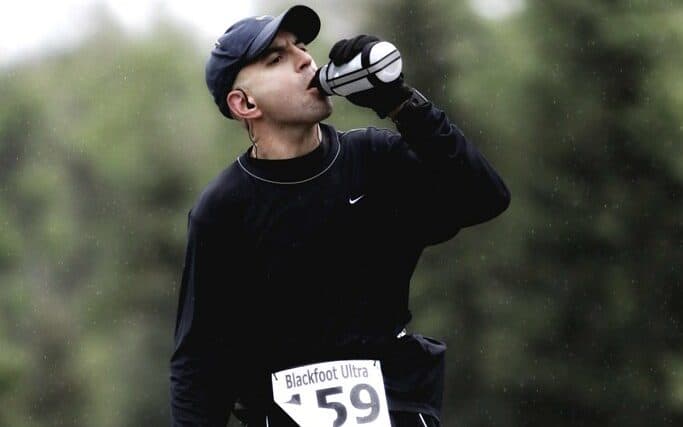
Rehydrate
As long as you’re going to eat a balanced meal later, you can rely on regular water for rehydration. If not, get a sports drink to rebalance your electrolytes.
Diluted juice is also an option if sports drinks aren’t your thing. They have enough water to hydrate, sugar to rebuild glycogen, and electrolytes too.
Try to drink small portions repeatedly instead of gulping down a whole bottle in a few minutes. Drink in moderation till you feel like you’re not thirsty anymore.
Rest
Once you get home and finish a carbohydrate-loaded meal (not junk food, though!) it’s time to rest.
For a runner, an ice bath is typically the easiest road to recovery. It helps calm down sore muscles and cool burning feet.
After 20 or 30 minutes of an ice bath, get some rest. Later that night, you can do some light stretches. Very light stretches. Don’t exhaust yourself any further.
The Take-Away
It’s hard to define a marathon runner’s body in clear terms. In general, a marathon runner should have a low body fat content, strong bones, low heart rate, and excellent oxygen utilization.
Don’t compare yourself to elite runners too much. Not everyone was born to win the 26 miles run. However, any person can run a marathon if they put in the necessary endurance training. It might take you a few months of hard work, but you’ll get there.
Practice hard and be persistent. The thrill of getting through the finish line will be worth it in the end. But don’t let the adrenaline rush make you forget the three steps to recovery; refuel, rehydrate, and rest!

